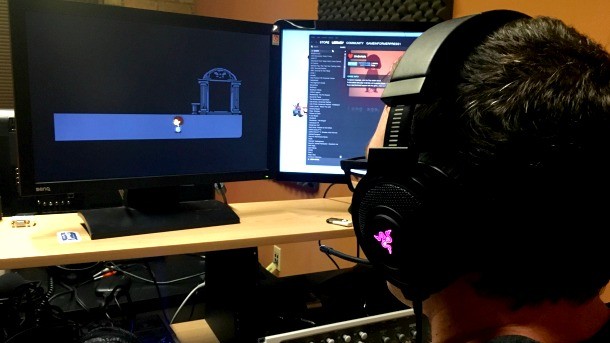Please support Game Informer. Print magazine subscriptions are less than $2 per issue
Peeking Into The Overly-Efficient Minds Of Speedrunners

Most Super Mario Bros. players wouldn’t think twice about picking up a fireflower during their playthrough. For speedrunners, however, doing so comes at too high a cost. Fireflowers make the game easier to complete, but take a few seconds to actually collect. Since the goal of a speedrunner is to finish a game in the quickest time possible, stopping to collect an item like a fireflower is as wasteful as pausing the game to take a sip of water. Any distraction can shave precious seconds off, destroying a run for record completion time.
Speedrunners will do anything to get a better time, even if it means exploiting glitches or undermining game systems. In Fallout 3, a speedrunning trick requires you to break your character's legs in order to get a speed boost. Once you jump off a nearby cliff, follow up by immediately saving and reloading. Since your character loses speed when breaking their legs and healing allows you to gain it back, you can trick the game into thinking you just healed your broken legs despite them being perfectly fine, thus allowing you to walk at 165% of your walking speed.
Knowing and mastering tricks like these takes regular and repetitive practice. Mastering the optimal routes in games requires often hundreds of hours of playtesting and note-taking if you want to come even close to current world record-holders. Games that normally take dozens of hours can be completed in mere minutes, and uncovering the glitches that allow speedrunners to finish games so quickly are often discovered as a whole within the larger speedrunner community rather than by just one individual player.
Speedrunners find pleasure in something that would normally come at a cognitive cost for others. They feel rewarded for working through problems related to optimization and efficiency most others would find too mentally taxing to be considered a hobby. This poses the question: If speedrunners are always getting better at solving shortest path problems and regularly exercising parts of their brain that usually go disengaged, do they see any benefits cross over into their everyday lives?
Tucker “BubblesDelFeugo” Olinsky currently holds the world speedrunning record for Fallout 4 at 49 minutes and 12 seconds. According to the timer he uses while speedrunning; he has approximately 750 attempts and around 100 completed runs for Fallout 4 so far. When Olinsky began speedrunning six years ago, he focused on Bethesda games and now speedruns for approximately 35 hours a week, regularly streams to his Twitch channel, and has even traveled globally to participate at speedrunning events.
Since he started playing, Olinsky has noticed some overlap into his normal day-to-day. “I definitely do things more efficiently now,” Olinsky says. “When I come back to my apartment and I have groceries, and I have to go to the bathroom, and I have to charge my phone, I’ll do everything in the order of which is closest to me because the end goal of the night is going to sleep...On the elevator rides going up to work I’ll try and answer as many emails as I can and that’s like a 16 second ride.”
Fellow speedrunner Brad M. (last name omitted by request), known as darbian on his Twitch channel, started speedrunning three years ago and focuses on games from the NES/SNES era. On average he speedruns about 10 hours a week while also working full-time as a software engineer. A few months ago, he secured the world record for Super Mario Bros. at 4 minutes, 57 seconds, 260 milliseconds. He also holds the record for Super Mario Bros.: The Lost Levels, and is the first person to complete the The Super Marihour Challenge, which consists of beating Super Mario Bros., Super Mario Bros.: The Lost Levels, Super Mario Bros. 2, Super Mario Bros. 3, Super Mario World, and Super Mario 64 one after the other in under an hour.
Brad noticed that speedrunning has started to positively affect his life outside of running as well. “I often find myself trying to optimize some of my daily routines, like getting ready in the morning, shopping after work, cooking dinner, or cleaning up in the evening,” he says. “Working full-time means I don't have a ton of time to speedrun/stream during the week, so I try to be as efficient as possible to give myself the most free time. Completing multiple tasks efficiently one after another is a great feeling. I can enjoy my free time more when I feel like I've earned it.”

Speedrunning Skills Transferring To The Real World
When it comes to video games, skills acquired through gameplay rarely transfer over into the real world. Spending hours playing Call of Duty won’t make you a better shooter if you’ve never held a gun, and playing Guitar Hero won’t make you a rock god if you’ve never plucked a string. However, speedrunners appear to be gaining real-world efficiency skills through the repetitious manner in which speedrunning encourages them to complete tasks.
In order to better understand how this connection is being formed, we talked to Dr. Paul Schrater, associate professor of psychology and computer science at the University of Minnesota. Schrater’s work has him using video games as critical experimental tools in order to, for example, analyze how the intrinsic motivations of League of Legends players affects the formulation of expertise. According to Schrater, the anecdotal evidence that speedrunners are gathering real-world skills through repetitive gameplay means a learning phenomenon might be hidden in the actions speedrunners take to complete games as quickly as possible over and over again.
“They’re learning a skill that is in fact transferable to their everyday life. Most things in games can’t transfer, but they’re figuring out how to transfer something that is more fundamental,” Schrater hypothesizes. “This is a new kind of bleed over that I think is exciting. It’s generalization. Generalization in learning is not common. The brain’s drive for efficiency means that most of the things you learn in one domain stay in that domain. They don’t transfer over.”
Since speedrunner’s routes often change due to newfound glitches or paths, they have to overlap their activities in a slightly different way every time they start a run. It’s a process of taking a whole game, dividing it up into its smaller and digestible parts, and then reforming it mentally in order to navigate from its beginning to end in the most efficient manner possible. Naturally our brains are averse to things that take mental energy to complete. According to Schrate, despite humans being the most intelligent creatures on the planet, we don’t like to think too hard, and our brains will seek out ways to subconsciously process our thoughts as efficiently as possible in order not to wear us out. Speedrunners appear to be challenging this aspect of their brains, pushing past the cognitive cost of thinking efficiently for long periods of time. “I think having hobbies like this are proving to be extremely good for your brain. They’re regularly exercising their brain in a way that most people aren't and they’re exercising it hard,” Schrater says.
Finding activities that require mental effort but aren't aversive means you have another reward present that's offsetting the costs. An extrinsic motivation for speedrunning would be getting the world record in any given game, while intrinsically speedrunners are perhaps just enjoying the act of puzzle solving as others would solving a Sudoku or finishing a crossword. “Most of the time it’s just for the purpose of knowing about how a lot of different games work, and increasing my library of games I can play quickly,” Olinsky says.
Speedrunning is not only completing repetitious tasks, but also creatively looking at the bigger picture as a whole. “The subconscious skills are there; they don’t have to think about them, but they do have to think about the problem of applying all of these basic skills, because it is different every time,” Schrater says. “If it was the same every time, then your efficient brain could just wash it all beneath your conscious mind.”
Perhaps because the path is never exactly the same in speedrunning, but it’s still a task that is highly repetitive in nature, and these efficiency skills are transferring over when they usually would stay locked within their own domains.

Could The Possible Benefits Of Speedrunning Apply To Anyone?
Past experimentation of gameplay’s effect on the brain has seen success across larger populaces. For example, scientists at The University of California, San Francisco (UCSF) found a distinct reversal of mental aging through gaming by having a group of older participants play a driving simulator in order to force their brains to absorb large amounts of sensory information. As we grow older, our bodies develop higher sensory filters in order to help our aging brains focus; however, this has a negative effect for elderly drivers who have to pay attention to multiple things while on the road at once. After 12 hours of training, participants aged between 60-85 years old had response times similar to those in their 20’s playing the game for the first time.
How would speedrunning fair if it was presented as a tool to test the efficiency skills of the public like a driving simulator can for sensory absorption? It’s hard to tell whether the efficiency skills seemingly gathered by speedrunners could be attributable to anyone who attempted the hobby, or if a certain type of person has the specific type of cognitive brain that can reap the benefits through the repetitive process. “These speedrunners may be a distinctive type, in which case we won't be able to transfer what they’re doing to the populace at large,” Schrater says. “But that’s what the research would need to show, that this kind of training actually works for most people, not just the few selected that like doing it already.”
Media Relations Manager for speedrunning charity event Games Done Quick (GDQ) Christopher Grant has been a speedrunner himself since 2012, and has been working with other speedrunners professionally with GDQ since February 2014. He believes a preemptive enjoyment of shortest-path problem solving is what connects the personality type of speedrunners together. “You kind of need to have that personality first to really enjoy it,” Grant says. “You spend a lot of time learning and optimizing, finding it interesting and entertaining to begin with I feel like is a key component.”
The daunting question becomes whether those who already have better efficiency problems skills are the ones drawn to speedrunning, or if speedrunning is in fact transferring skills into the daily lives of speedrunners. Perhaps these runners already have a higher aptitude for time management skills and they are simply being sculpted further through the repetitive nature of speedrunning. Grant agrees with this thought, saying “I feel like I have habits that apply to speedrunning that I’ve always had.” Brad M. believes he came into the hobby with some preemptive skills as well, saying, “I think that speedrunning plays to a lot of my strengths, attention to detail, hand-eye coordination, mental planning, and patience.”
Just like with our aging bodies, we should be challenging our brains and making them go through the full range of motions in order to upkeep their retention in learning processes with the plasticity to do so. The natural path of the brain is to be as efficient as possible by undergoing the least amount of mental effort required to function, and when you reside in an environment with no challenges you will have an efficient brain, but it will only be efficient in a limited amount of specified tasks. In terms of determining whether speedrunning could be an activity to help ensure the brain is worked thoroughly, it’s too early to make any conclusions. As Schrater says, “I think this has the potential of stimulating some interesting research on learning in generalization.”










